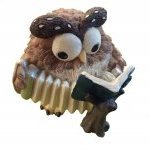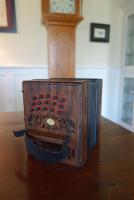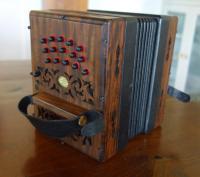Search the Community
Showing results for 'meantone'.
-

Fiddlin' around with the concertina.
Anglo-Irishman replied to wunks's topic in General Concertina Discussion
To be quite blunt about it, the violin or fiddle - in the right hands - is a microtonal instrument. It doesn't oblige you to choose between equal temperament and meantone. If the tonal situation calls for "a rather sharp B-flat" (as a choirmaster of mine once required of us singers), a violinist can do that, too. A concertinist? No! The nearest you can get to that is off-tuning the redundant enharmonics on an EC, but I believe you have to decide on the degree (comma) of meantone you want, and you're stuck with it. Double stops, trills, sforzando - all violin tricks that are doable on a concertina. Trills are probably easier in an EC or duet than on an Anglo (unless you've got the two notes for the trill in one bellows direction). But sliding up to the intended note, as especially American fiddlers tend to do, is not concertina territory. In the fretted-strings fraternity, the guitarists tend to think that mandolins, banjos, citterns, etc. are just rather quirky guitars. They're not! Each can do lots of things that the guitar can't. Let's not fall into the trap of thinking that the concertina is the "egg-laying wool-milk-pig" as we Germans say! ? Cheers, John -
I have just bought a nice 20 button George Jones anglo. Apart from a few minor holes in the bellows, now fixed, it's in pretty good shape, with very sweet sounding brass reeds, more or less in tune to old philharmonic pitch, possibly combined with some variety of meantone. But on checking the tuning I discovered that the bottom button of the lower G row does not play the standard B/A but instead plays G/D. Has anyone else come across this variation, and can anybody tell me whether it has any advantages? I think I would miss the low A for tunes played in the lower C register, but possibly there is some advantage in this layout for the G chords? I wonder if any of the musicians on this forum could advise me?
-

Mean Tone, Centre Point And Playing With Others
Chris Ghent replied to Little John's topic in General Concertina Discussion
I have a 1/5 comma meantone anglo centred on G. I find no-one notice the pitch differences in my regular sessions but I am always a little reluctant to give an A for tuning when asked because it is 4 cents out. The concertina is not just sweeter in chords, it seems when playing melody your mind adds up the intervals on the fly and the notes seem sweeter. Having said all that, I would not go out of my way to tune to 1/5th again as the gain is a little too small even though there is no real pain. If I was sure I would be playing on my own for a long time I would shift to 1/4 without a pause. -
I currently play a lovely C/G 31 button concertina, a very early Crabb that was overhauled by Greg Jowaisas, with beautiful new bellows and tuned in 1/5 comma meantone. I love the concertina, but as luck would have it, I have another long awaited C/G from a contemporary maker coming my way this spring. Since I don't have a need for two C/G anglos, I thought I'd put the feelers out there: Here's a few photos of the Crabb
-
What's This Tuning Temperament?
denj.jones replied to harpomatic's topic in General Concertina Discussion
Yes Steve , but we need one that will work with a 14 tone scale which is why I use the one I have mentioned on another thread... I can repeat here if anyone wishes. I have a 40 button English Wheatstone that is over 170 years old. it has 14 notes to the octave and tuned to 448hz 1/4 comma meantone as proposed by OTTO GIBELLIUS, Propositiones mathematico-musicae, Munden, 1666. it has C as the root = 0 cents and is identical to Aarons meantone except for the extra 2 notes Dsharp = -31.5 cents and Gsharp = -28 cents. -
Beginner Question : Vintage Or Cheap Hybrid ?
Craftydab replied to Terence's topic in General Concertina Discussion
As I had no idea what a 1/4 comma meantone was I looked it up. (Wikipedia) And the construction of same. I’m none the wiser now! Best stick to just learning the dots and practising me thinks. -
That 5A sounds so good! Is that ET or maybe a meantone tuning? Anyway, I really enjoyed listening to your concertina and to your playing. Thx. Don.
-

What's This Tuning Temperament?
Don Taylor replied to harpomatic's topic in General Concertina Discussion
Regarding the OP's A=442Hz. I recall that some fiddle players tune their fiddles a cent or two high in order to punch through a crowd of other instruments - not really out of tune, but just a touch sharper than everybody else. (Of course, then all the other fiddle players start to do the same thing...) Maybe a previous owner of your concertina deliberately had it tuned to 1/5 comma meantone centred on A=442Hz. -

What's This Tuning Temperament?
Geoff Wooff replied to harpomatic's topic in General Concertina Discussion
Wolf & Adrian, I currently do not own an EC in ET. The one I had last year went back to the man I'd bought it from... he missed it so much . Steve; I have a preference for 1/5th Comma . If it is numbers you are looking for I did post these in an earlier discussion on Meantone. I'll see if I can locate it..... PS: entering 'Meantone' in the search box will give access to quite a few discussions on the subject. -

What's This Tuning Temperament?
adrian brown replied to harpomatic's topic in General Concertina Discussion
Steve, we discussed this here a while ago: http://www.concertina.net/forums/index.php?showtopic=18877&page=1 I was hoping somebody having access to both a 1/5th meantone tuned concertina and one in ET would do a similar video because I think it would be very useful to compare the two. Anyone want to volunteer? Adrian -
What's This Tuning Temperament?
harpomatic replied to harpomatic's topic in General Concertina Discussion
Steve, based on my understanding of a current situation, 1/5 is preferable, its a bit closer to Et, sweetened chords, but still not too clashing with ET tuned playing partners (given that you're tuned to the same concert pitch.) The genius of EC is that you get both enharmonics, this way the layout makes so much more sence... (correct me if I am wrong, I just started my excursion into this meantone territory) -

What's This Tuning Temperament?
Geoff Wooff replied to harpomatic's topic in General Concertina Discussion
Go to www.dolmetsch.com/musictheory27.htm for much information on Pitches and Temperaments. There is a post or two on this forum where there are lists of figures in Cent deviations from ET for several Meantone scales. -
What's This Tuning Temperament?
harpomatic replied to harpomatic's topic in General Concertina Discussion
John, thanks for pointing out lack of relevant info (though I know that concert pitch isn't any temperament:), I was hoping that perhaps a given "modern" pitch + just a mere fact of different enharmonics may lead to a quick guess. Wrong assumption on my part, but your advice lead to a good session of more precise measuring on a better tuner (though, who knows, really), and I get a pretty consistent read out for the first time: First, my A is 443 (not 442). All my Ab, Eb, Bb are +15 cents sharp, throughout the instrument. All F#, C#, G# and D# are -15 cents flat. All B's are -5, F's and C's are +5. I never really play anything other than ET, so never got into particularities of other temperaments, though I have a good basic understanding of what's at play. On a retunable instrument, like pedal steel, there's much discussion about temperaments, but I am an ET believer, so just tune to that and "meantone" me not, so to say... However, this tuning sounds very nice, and seems to be consistent and deliberate, which rules out just being out of tune. Got me curious as to what it actually is. -

What's This Tuning Temperament?
Anglo-Irishman replied to harpomatic's topic in General Concertina Discussion
Harpo, "A=442", "A=436" etc. are not temperaments, but rather concert pitches. An instrument can be equal tempered, just or meantone at any concert pitch. Temperament has to do with the intervals between the notes. The differently tuned enharmonics are an indication that the concertina is not in equal temperament.To determine exactly what non-equal-tempered tuning you have, you'd have to use an electronic tuner (adjusted for your A=442) to ascertain how many cents what notes are flat or sharp of ET. Then ask the experts on this Forum! Cheers, John -

Beginner Question : Vintage Or Cheap Hybrid ?
Don Taylor replied to Terence's topic in General Concertina Discussion
A brass reeded 20B tuned to 1/4 comma meantone: https://youtu.be/nq70e3T7jVo -

For Sale Lachenal 20 Buttons (And Trade For Stagi)
Don Taylor replied to papawemba's topic in Buy & Sell
Jim I don't really object to the Stagi sound, but I love the warm, smooth, liquid tone that some of these old 20 button Lachenals have - clacking levers and all. The sound of the OPs concertina reminded me of Sqzbxr's 20 button tuned in 1/4 comma meantone playing Sally Gardens. Sigh, now you have got me thinking of buying it again! A little too much Jameson's this evening I suppose... Don. -
Hi all, I'm selling my Tedrow 30 button Harley-inspired CG. Bob Tedrow built it; it is one of only two or three of his Harley-inspired Anglos. I had it tuned in quarter comma meantone so that the chords would be sweet. Here Bob describes it and posts some audio clips (mine is the one in meantone tuning): http://hmi.homewood.net/harley/ I had visions of playing this period-type square-ender for some Civil War re-enactors dances, but that never happened! A square-ended Anglo very like this one in appearance is at the Gettysburg museum in Pennsylvania. Attached below (and in Bob Tedrow's article) are some photos. It is in nearly mint condition. The hybrid reeds are efficient and the action is fast. No case, but I'm including the casual soft case that I used for it. Price $2000 plus shipping and insurance, payment via PayPal. Contribution to c.net if it is sold here. Cheers, Dan
-
Well Don, in reference to C# /Db these are the same note in Equal Temperament and unless one created a keyboard with separate buttons for these two notes and used an altogether more complex tuning system we can only use the C# button for either note. In the example I have given (G,Eb,Db,Bb) Bach gives us an arpeggio of Eb7 in which the C# ,in 1/5th Comma Meantone, is perfectly sweet as a replacement for his written Db... So although I had no possible alternative the 'whichever sounds best' rule has applied itself. When discords do appear they show us the extent of the possible use of a Meantone tuning and we should perhaps retreat to a more useable key or go for Equal Temperament. One clarifying point to Bellowbell's question; choosing the wrong enharmonic ( which is usually the one that is out of pattern on the EC, unless you are in a really far out key) can negate the ability to easily transpose the tune to another key . If we take the Hayden duet, as an example of which enharmonic one would choose , notice that the Eb's and Ab's are on the left side of the keyboard and the G#'s and D#'s and on the right.....and it follows that when one is playing in keys like F# and B it naturally follows that G# and D# would be used and when one is playing in Bb and Eb it is the Ab and Eb that are used. I can see that Bach's G,Eb,C#,Bb arpeggio is quite a stretch on the Hayden. Geoff.
-
"Bourrée from the French suite in Eb by JS Bach ( BWV 819). In the B part second bar there is a downward run G,Eb,Db,Bb which one could play as G,D#,C#,Bb for a nice alternating right-left-right-left fingering but my personal rule ( and the need to keep harmonically 'in the arpeggio ' with my Mean Tone tuning) makes me play G,Eb,C#,Bb." Geoff: When playing an instrument in meantone tuning and you need to play a note that is out of key and is one the now non-enharmonic pairs, such as the C#/Db in your example, how do you choose which note to play? Is there a rule other than whichever sounds best? Thx. Don.
-
As a long term user of Meantone temperaments on the EC my tendance is to stick with the harmonic choice for the key signature. This usually keeps the logical fingering movements , and chord shapes fairly standard through four keys flat and four sharp of C maj. I find this makes transposition easier because my brain has assimilated the pattern strategy. As a 'for instance' ; some people like to change the low G# on a 48 Treble to an F natural... now this would bother me if I was playing in A because I would need to go 'out of pattern ' to use the Ab button for the missing G#. When playing in keys further away from C or when the music is very chromatic and one needs to substitute , C# for Db for example, then complexities of fingering might call for a 'best option' fingering. So, as a basic approach I find myself using the G# and D# buttons in all Sharp key signatures and the Ab and Eb buttons for all the Flat key signatures. If your sheet music says play an Eb I think it is a better policy to do that and not substitute the D# because it might be easier. An example piece with difficult single line melody where I could substitute but do not: Bourrée from the French suite in Eb by JS Bach ( BWV 819). In the B part second bar there is a downward run G,Eb,Db,Bb which one could play as G,D#,C#,Bb for a nice alternating right-left-right-left fingering but my personal rule ( and the need to keep harmonically 'in the arpeggio ' with my Mean Tone tuning) makes me play G,Eb,C#,Bb.
-
Well, when the concertina was invented, before today's dominance of equal temperament, the two 'same-sounding notes' on many concertinas would probably have been tuned differently. This gives purer-sounding chords in common keys, as the mathematical ratios between the frequencies are closer to simple fractions, and the brain seems to like that. This was done as part of a 'just' or 'meantone' temperament tunings. It is still done occasionally today, particularly for people who play solo, or play with fiddles who (often unconsciously) adjust the pitch of these 'enharmonic pairs' according to the key. However most concertinas these days are tuned to equal temperament so that they fit with other instruments like pianos, and don't have preferred keys to play in. So, assuming your instrument is in equal temperament (the enharmonic pairs sound the same) then you have no musical reason to choose a D# or an Eb, so go for whichever is easier for you. However my choices are affected by at least two factors: 1) finger ergonomics - it's often easier to reach one of the two than the other, because of fingers needed for preceding or following notes. So use the button under the easier finger. 2) brain power - if I read a D# from the music, it takes extra brain power to do the translation and think that I could be using an Eb - it's easier on the brain to play the D#. So, it's a balance - I more often play the note 'as written', but if the finger ergonomics are a problem I switch to the enharmonic pair without worrying. Does that help?
-

Quarter Comma Meantone - What Root Note?
alex_holden replied to Terry McGee's topic in General Concertina Discussion
I've just been doing some experimentation with the tuning app I use (Tonal Energy Tuner for IOS devices), and it turns out that it automatically adjusts its pitch reference in the way that we have been discussing. If you tell it that A4=440 and you want to use quarter comma meantone in the key of G, it actually builds the scale from G4=392 (i.e. an equal tempered G). If I switch it to a different root note, it builds the scale from the equal tempered pitch of that note instead. This app has another useful feature for playing around with alternate temperaments. You can play notes and chords on a virtual piano, and switch back and forth between ET and an alternate temperament with one tap. You can also manually add other temperaments that it doesn't already have in its database (e.g. 1/5th comma MT).- 37 replies
-
- Temperament
- meantone
-
(and 1 more)
Tagged with:
-

Quarter Comma Meantone - What Root Note?
Don Taylor replied to Terry McGee's topic in General Concertina Discussion
In 2016 Geoffrey published a simple list of offsets for 1/5 comma meantone tuning centred on the key of C. Is there a similar list for 1/4 comma meantone?- 37 replies
-
- Temperament
- meantone
-
(and 1 more)
Tagged with:
-

Quarter Comma Meantone - What Root Note?
adrian brown replied to Terry McGee's topic in General Concertina Discussion
Thanks Adrian. I'm still trying to fully get my head around unequal temperaments, but doesn't the Hayden layout (theoretically at least, if the keyboard is big enough) have all the enharmonic pairs? https://en.wikipedia.org/wiki/File:Wicki-Hayden_Musical_Note_Layout.png This post by Geoff seems to say this is possible, in 1/5 comma meantone anyway. In which case, a 46 button Hayden (and the 42 and 52 button Haydens) should be a good candidate for meantone tuning. So what about my suggestion of tuning the enharmonic notes on a duet to different bellows directions? I don't see why it wouldn't work and you could have all 5 'black' notes tuned that way, greatly increasing the number of keys you could use with a meantone temperament. Learning where they are and how you could play certain chords in one direction only would be no more difficult than how anglo players have to remember bellows direction and at least the buttons would be the same for d#/eb, a#/bb etc... Adrian Adrian- 37 replies
-
- Temperament
- meantone
-
(and 1 more)
Tagged with:
-

Quarter Comma Meantone - What Root Note?
Don Taylor replied to Terry McGee's topic in General Concertina Discussion
Thanks Adrian. I'm still trying to fully get my head around unequal temperaments, but doesn't the Hayden layout (theoretically at least, if the keyboard is big enough) have all the enharmonic pairs? https://en.wikipedia.org/wiki/File:Wicki-Hayden_Musical_Note_Layout.png The 46 button Hayden does not have the enharmonic pairs, a 65 button would but now we are talking about hen's teeth. As for other duets: The 48 and 55 button Cranes do not have enharmonic pairs, some really big Cranes seem to have at least some of the pairs. Looking at Robert Gaskin's chart for an 81-button MacCann I don't see any enharmonic pairs - just G#'s (no Ab's) and Eb's (no D#'s). I stand to be corrected on these instruments. I think that most folks (not all, but most) only use what Brian Hayden calls the "Easy-Peasy" keys on their Hayden concertinas - the keys that all follow the same regular pattern. Although, in theory, a 46 button Hayden is fully (ET) chromatic, in practice I think of it as mainly a diatonic instrument in its easy-peasy keys but in each of these keys any occasionally needed (ET) chromatic note is there, just not in one of the regular places. I suppose that you could play in any of the non-easy-peasy keys on a 46 button, but lots of sharps or even a few flats would have you stretching all over the keyboard. The 46 button easy-peasy keys are all contiguous in the circle of fifths (F, C, G, D, A, E) so, if you accept that you are going to be limited to those keys then why not go with a meantone tuning that works well for for that set of keys and to hell with the other keys? (This is meant as a genuine question, BTW, not a rhetorical question). This post by Geoff seems to say this is possible, in 1/5 comma meantone anyway. In which case, a 46 button Hayden (and the 42 and 52 button Haydens) should be a good candidate for meantone tuning.- 37 replies
-
- Temperament
- meantone
-
(and 1 more)
Tagged with:






